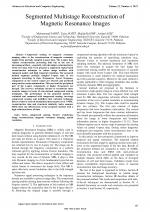| 4/2021 - 12 |
Segmented Multistage Reconstruction of Magnetic Resonance ImagesFARIS, M. |
| Extra paper information in |
| Click to see author's profile in |
| Download PDF |
Author keywords
compressed sensing, Fourier transforms, image reconstruction, magnetic resonance imaging, spatial resolution
References keywords
sensing(14), resonance(10), magnetic(10), reconstruction(9), imaging(9), image(9), jmri(5), dynamic(5), medicine(4), chen(4)
Blue keywords are present in both the references section and the paper title.
About this article
Date of Publication: 2021-11-30
Volume 21, Issue 4, Year 2021, On page(s): 107 - 114
ISSN: 1582-7445, e-ISSN: 1844-7600
Digital Object Identifier: 10.4316/AECE.2021.04012
Web of Science Accession Number: 000725107100012
SCOPUS ID: 85122239175
Abstract
Compressed sensing of magnetic resonance imaging refers to the reconstruction of magnetic resonance images from partially sampled k-space data. The k-space data reduces reconstruction processing time but at the cost of increasing artifacts - especially with the higher reduction factor of the raw data. This work proposes a segmented region-based reconstruction technique to reduce image artifacts with enhanced quality and high temporal resolution. The proposed method segments partially sampled k-space data in two segments according to their frequencies. Lower frequency components at the central region are selected and predicted using nuclear norm minimization. This part and the peripheral part of the k-space components at higher frequencies are merged. The recovery technique iterates to reconstruct more accurate images in terms of conventional compressed sensing techniques. The performance of the proposed method is evaluated and compared with compressed sensing, two-stage compressed sensing, and modified total variation technique. Better results in term of normalized mean square error NMSE, reconstruction time and structural similarity index measure SSIM show the effectiveness of the proposed method with a high reduction factor of data. |
| References | | | Cited By |
Web of Science® Times Cited: 1 [View]
View record in Web of Science® [View]
View Related Records® [View]
Updated today
SCOPUS® Times Cited: 1
View record in SCOPUS® [Free preview]
View citations in SCOPUS® [Free preview]
[1] McSTRA: A multi-branch cascaded swin transformer for point spread function-guided robust MRI reconstruction, Ekanayake, Mevan, Pawar, Kamlesh, Harandi, Mehrtash, Egan, Gary, Chen, Zhaolin, Computers in Biology and Medicine, ISSN 0010-4825, Issue , 2024.
Digital Object Identifier: 10.1016/j.compbiomed.2023.107775 [CrossRef]
Disclaimer: All information displayed above was retrieved by using remote connections to respective databases. For the best user experience, we update all data by using background processes, and use caches in order to reduce the load on the servers we retrieve the information from. As we have no control on the availability of the database servers and sometimes the Internet connectivity may be affected, we do not guarantee the information is correct or complete. For the most accurate data, please always consult the database sites directly. Some external links require authentication or an institutional subscription.
Web of Science® is a registered trademark of Clarivate Analytics, Scopus® is a registered trademark of Elsevier B.V., other product names, company names, brand names, trademarks and logos are the property of their respective owners.
Faculty of Electrical Engineering and Computer Science
Stefan cel Mare University of Suceava, Romania
All rights reserved: Advances in Electrical and Computer Engineering is a registered trademark of the Stefan cel Mare University of Suceava. No part of this publication may be reproduced, stored in a retrieval system, photocopied, recorded or archived, without the written permission from the Editor. When authors submit their papers for publication, they agree that the copyright for their article be transferred to the Faculty of Electrical Engineering and Computer Science, Stefan cel Mare University of Suceava, Romania, if and only if the articles are accepted for publication. The copyright covers the exclusive rights to reproduce and distribute the article, including reprints and translations.
Permission for other use: The copyright owner's consent does not extend to copying for general distribution, for promotion, for creating new works, or for resale. Specific written permission must be obtained from the Editor for such copying. Direct linking to files hosted on this website is strictly prohibited.
Disclaimer: Whilst every effort is made by the publishers and editorial board to see that no inaccurate or misleading data, opinions or statements appear in this journal, they wish to make it clear that all information and opinions formulated in the articles, as well as linguistic accuracy, are the sole responsibility of the author.





